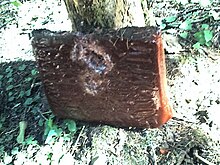

Pykrete (/ˈpaɪkriːt/, PIE-creet)[1] is a frozen ice composite,[2] originally made of approximately 14% sawdust or some other form of wood pulp (such as paper) and 86% ice by weight (6 to 1 by weight).
During World War II, Geoffrey Pyke proposed it as a candidate material for a supersized aircraft carrier for the British Royal Navy. Pykrete features unusual properties, including a relatively slow melting rate due to its low thermal conductivity, as well as a vastly improved strength and toughness compared to ordinary ice. These physical properties can make the material comparable to concrete, as long as the material is kept frozen.
Pykrete is slightly more difficult to form than concrete, as it expands during the freezing process. However, it can be repaired and maintained using seawater as a raw material. The mixture can be moulded into any shape and frozen, and it will be tough and durable, as long as it is kept at or below freezing temperature. Resistance to gradual creep or sagging is improved by lowering the temperature further, to −15 °C (5 °F).
- ^ "Definition of PYKRETE". www.merriam-webster.com.
- ^ "Ice Alloys" (PDF).